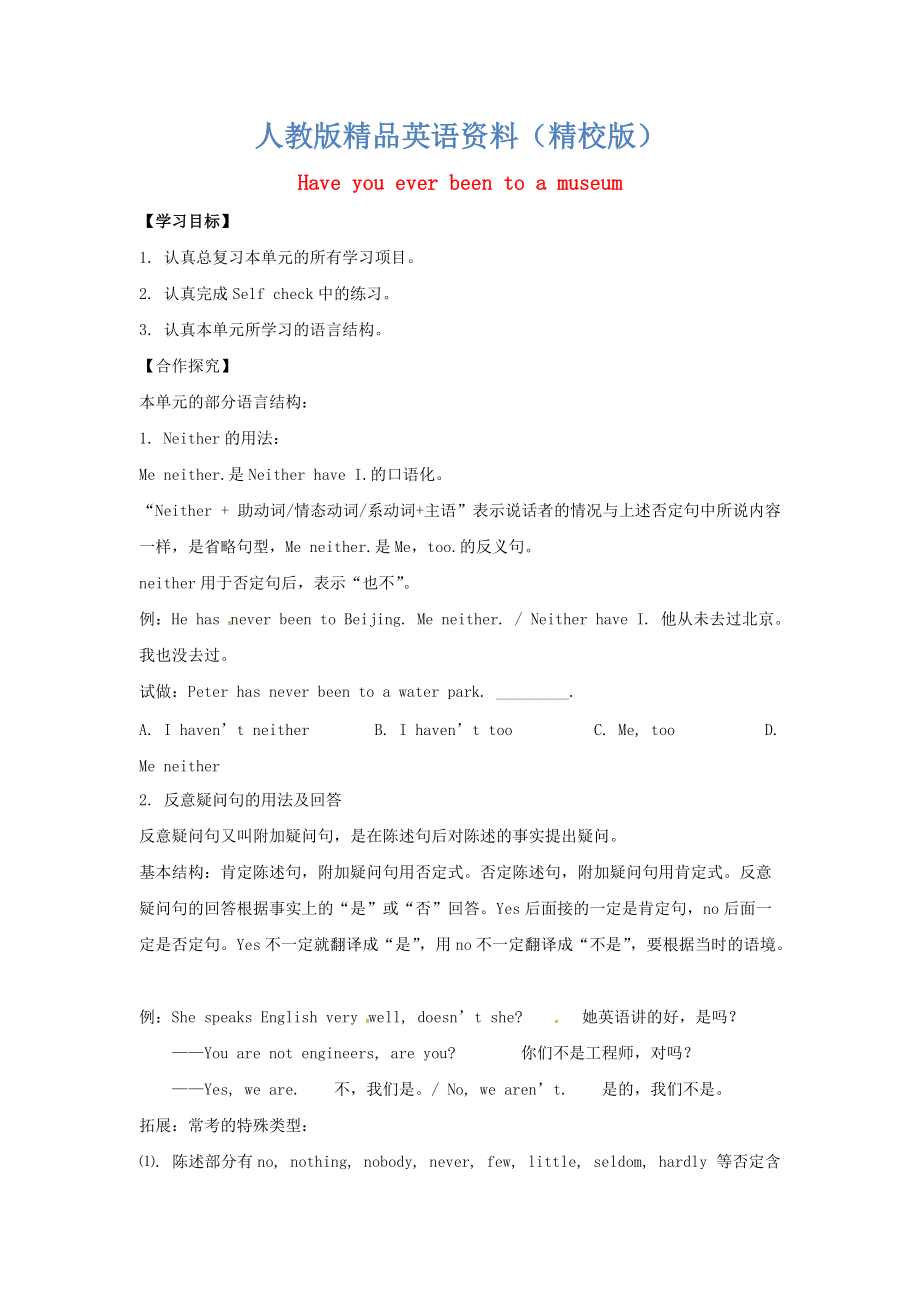《【精校版】西安市八年級英語下冊 Unit 9 Have you ever been to a museum Period 4導(dǎo)學(xué)案人教新目標(biāo)版》由會員分享�,可在線閱讀,更多相關(guān)《【精校版】西安市八年級英語下冊 Unit 9 Have you ever been to a museum Period 4導(dǎo)學(xué)案人教新目標(biāo)版(3頁珍藏版)》請?jiān)谘b配圖網(wǎng)上搜索��。
1�、人教版精品英語資料(精校版)
Have you ever been to a museum
【學(xué)習(xí)目標(biāo)】
1. 認(rèn)真總復(fù)習(xí)本單元的所有學(xué)習(xí)項(xiàng)目。
2. 認(rèn)真完成Self check中的練習(xí)�����。
3. 認(rèn)真本單元所學(xué)習(xí)的語言結(jié)構(gòu)。
【合作探究】
本單元的部分語言結(jié)構(gòu):
1. Neither的用法:
Me neither.是Neither have I.的口語化���。
“Neither + 助動詞/情態(tài)動詞/系動詞+主語”表示說話者的情況與上述否定句中所說內(nèi)容一樣���,是省略句型,Me neither.是Me�����,too.的反義句����。
neither用于否定句后,表示“也不”�����。
例:He
2�、has never been to Beijing. Me neither. / Neither have I. 他從未去過北京。我也沒去過���。
試做:Peter has never been to a water park. _________.
A. I haven’t neither B. I haven’t too C. Me, too D. Me neither
2. 反意疑問句的用法及回答
反意疑問句又叫附加疑問句��,是在陳述句后對陳述的事實(shí)提出疑問��。
基本結(jié)構(gòu):肯定陳述句�,附加疑問句用否定式��。否定陳述句���,附加疑問句用肯定式
3��、��。反意疑問句的回答根據(jù)事實(shí)上的“是”或“否”回答�����。Yes后面接的一定是肯定句��,no后面一定是否定句�。Yes不一定就翻譯成“是”�����,用no不一定翻譯成“不是”�,要根據(jù)當(dāng)時(shí)的語境�。
例:She speaks English very well, doesn’t she? 她英語講的好�,是嗎?
——You are not engineers, are you? 你們不是工程師���,對嗎���?
——Yes, we are. 不,我們是���。/ No, we aren’t. 是的�����,我們不是�。
拓展:?�?嫉奶厥忸愋停?
⑴. 陳述部分有no, nothing, no
4���、body, never, few, little, seldom, hardly 等否定含義的詞時(shí)�����,附加譯文用肯定形式���。例:There is little water in the cup, is there? 杯子里只有一點(diǎn)水����,對嗎�����?
⑵. 祈使句的反意疑問句一般用“will you���?”;以 let me 和 let us 開頭的祈使句�,后面用“will you?”;
以let’s 開頭的祈使句變反意疑問句時(shí)��,后面用“shall we?”��。
例:Let’s go and listen to music, shall we? 咱們?nèi)ヂ犚魳钒?��,好嗎?
⑶. 陳述部分為I
5�、 am···時(shí)��,附加疑問用“aren’t I?”;當(dāng)陳述部分以I wish開頭時(shí)�����,疑問部分常用“may I?”�����。例:I am as tall as your sister, aren’t I? 我和你妹妹一樣高不是嗎��?
⑷. 主句含有I think / suppose / believe / guess / expect, 變反意疑問句時(shí)����,注意否定的轉(zhuǎn)移。
例:I don’t think he will come, will he? 我認(rèn)為他不會來����,對嗎?
試做:I don’t think they can make everything good enough
6���、,__________?
A. do I B. can they C. can’t they D. don’t I
I don’t think she will agree with us, __________?
A. will she B. won’t she C. don’ you D. do you
完成反意疑問句:Let’s go to see a movie, _________?
3. unbelievable adj. 難以置信的��;不真實(shí)的��。作表語或定語
7�、。反義詞為believable(可信的)���。
拓展:believe v. 相信�����;認(rèn)為���。I / We believe 后接that 引導(dǎo)的從句時(shí)注意否定轉(zhuǎn)移�����。
例:I don’t believe he can answer the question, can he? 我認(rèn)為他不能回答這個(gè)問題��,對不對����?
4. progress v. 進(jìn)步;進(jìn)展�����。
固定搭配:⑴make progress 取得進(jìn)步����;取得進(jìn)展
試做:If you _______ _______ _______ _______ , you must _______ _______. 如果你想進(jìn)步�,你就得更加努力學(xué)習(xí)�。
⑵
8、make progress in··· 在···方面取得進(jìn)步
試做:The teacher hopes that I can _______ _______ _______ _______. 老師希望我在科學(xué)方面取得進(jìn)步����。
5. encourage為及物動詞,意為“鼓勵(lì)”�����。固定搭配:encourage sb to do sth 鼓勵(lì)某人去做某事���。
試做:翻譯句子:老師鼓勵(lì)我再試一次��。_________________________________________________.
王先生總是鼓勵(lì)我們在課堂上說英語�����。_________________
9���、_____________.
6. 辨析:方位介詞 in, on, to
介詞in, on, to 都可以與表示方向的名詞 east, west, north, south, northeast, northwest, southeast, southwest連用。
⑴. 甲地在乙地境內(nèi)用in��。 Qingdao is in the east of Shandong Province. 青島位于山東省東部。
⑵. 甲地與乙地兩個(gè)相互獨(dú)立的地區(qū)并且不相連(有一段距離)用to.
Japan is to the east of China. 日本在中國的東部���。
⑶. 甲地與乙地相連(鄰)時(shí)���,用on.
The State of Mongolia is on the north of China. 蒙古國與中國的北部接壤。
【反思】
 【精校版】西安市八年級英語下冊 Unit 9 Have you ever been to a museum Period 4導(dǎo)學(xué)案人教新目標(biāo)版
【精校版】西安市八年級英語下冊 Unit 9 Have you ever been to a museum Period 4導(dǎo)學(xué)案人教新目標(biāo)版

